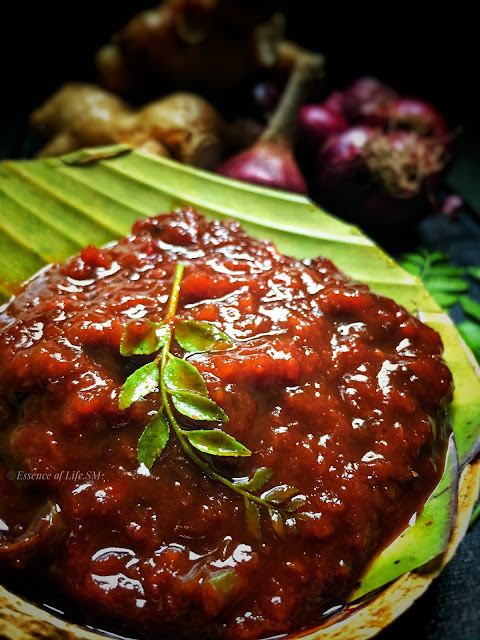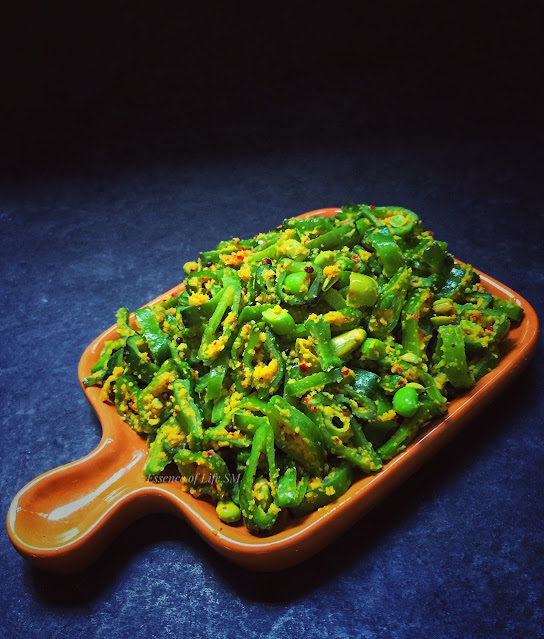Then, there's the Varutharacha Inji Puli – a name that rolls off the tongue like a melody. In this intricate variation, each ingredient, from ginger to green chillies and curry leaves, takes a captivating journey. They're first meticulously minced, then sautéed to perfection in the embrace of coconut oil, and finally, transformed into a dance of flavours as they're pounded and united into the iconic Varutharacha Inji Puli. This version isn't just a dish; it's an artisanal masterpiece that pays homage to the art of cooking.
 |
| 'Amma's Palakkad Style Inji Puli' – a symphony of flavours and memories |
But let's dive deeper into the soul of the recipe – the Palakkad Style Inji Puli. Here, the culinary narrative expands to include shallots, companions to ginger, green chillies, and curry leaves. The symphony of flavours unfolds as tamarind paste and jaggery intertwine with an ensemble of spices, a tantalizing blend of sweet, tangy, and spicy that's finished with the flourish of asafoetida powder and fenugreek seeds. It's a legacy recipe, passed down through generations, a testament to the flavours that define family and heritage.
Inji Puli isn't just food; it's a bridge between generations, "Catacomb of memories" that stand the test of time. For me, this tamarind condiment isn't just a culinary creation – it's a treasure trove, an essential remedy. When sickness lingers and cravings take over, my tongue yearns for the soothing embrace of Inji Puli. It's a comfort that transcends taste, a healing agent to my soul.
So, as you journey into your kitchen, armed with these recipes and a heart full of stories, remember that you're not just cooking – you're weaving tales of flavour, nostalgia, and love. Let the aromas guide you, and let each dish be a tribute to the culinary heritage, shared through the language of food.
Explore further Kerala Sadhya Recipes here...
Culinary Style - South Indian Recipe (Kerala)Skill Level - Intermediate
Yield - 2 to 2.5 Cups
Created By - SM
Ready to Relish - Instant
Discover more Culinary Treasures from God's Own Country here...
"Amma's Palakkad Style Inji Puli: A Symphony of Flavours and Memories"
 |
| 'Amma's Palakkad Style Inji Puli' – a symphony of flavours and memories |
Ingredients:
Palakkad Style Inji Puli:
- 3 tablespoons Coconut oil
- 1/2 teaspoon Mustard Seeds
- 1/4 teaspoon Fenugreek seeds
- 2 Dry Red Chillies
- 1/4 teaspoon Asafoetida powder
- 1/2 cup Ginger, finely chopped
- 4-5 Green chillies, slit
- A handful of Curry leaves
- 6–8 Shallots, sliced
- 1/2 teaspoon Turmeric powder
- 1 teaspoon Red chilli powder (adjust to taste)
- 2 tablespoons Tamarind paste
- Salt to taste
- 2 tablespoons Jaggery (adjust to taste)
- Water as needed
Method:
- Heat 2 tablespoons of coconut oil in a pan. Splutter the mustard seeds and the fenugreek seeds. Add dry red chillies, asafoetida powder (if using) and allow them to sizzle for a moment.
- Add finely chopped shallots, ginger, green chillies, and curry leaves. Sauté them until the shallots turn golden, and the ginger is aromatic.
- Stir in the turmeric powder and red chilli powder. Mix well to coat the ingredients evenly. Add the tamarind paste, jaggery, and salt. Pour in water as needed to create a slightly thick consistency. Allow it to simmer until the flavours meld.
- Once the oil separates & the mixture thickens to your desired consistency, turn off the heat.
- Let Palakkad Style Inji Puli cool before transferring it to a jar. Store in the refrigerator.
 |
| 'Amma's Palakkad Style Inji Puli' – a symphony of flavours and memories |
Notes:
- Flavourful Tradition: Palakkad Style Inji Puli isn't just a recipe; it's a culinary tradition that encapsulates the rich tapestry of flavours from the Palakkad region of Kerala. Each ingredient adds its unique essence to create a harmonious symphony of tastes.
- Tamarind and Jaggery Balance: The balance between tanginess from tamarind and sweetness from jaggery is key to achieving the signature taste of Inji Puli. Adjust the quantities to suit your palate and achieve the desired balance of flavours.
- Fragrant Tempering: The tempering of asafoetida powder and fenugreek seeds in coconut oil is the aromatic finale that elevates the dish. The crackling sound and the aroma of this tempering signal the final touch of perfection.
- Adjust Spice Levels: Red chilli powder and green chillies contribute to the heat of the dish. Feel free to adjust these quantities based on your spice tolerance. Remember, the balance between heat and tang is key.
- Versatile Pairing: This versatile dish beautifully complements various meal settings. This recipe effortlessly fits into a traditional Sadhya spread, adding a tangy and spicy dimension to the festive Onam Sadhya. It stands proud as a side dish for your everyday lunch, seamlessly complementing the flavours of rice and curries. Additionally, its rich and comforting taste pairs beautifully with curd rice, kanji (rice porridge), paal kanji etc., offering a soul-soothing experience.
 |
| 'Amma's Palakkad Style Inji Puli' – a symphony of flavours and memories |
Whether it's a grand celebration or a simple meal, this Palakkad Style Inji Puli brings a touch of tradition and a burst of flavours to your table. As you whip up these Inji Puli variations, remember that you're not just following recipes – you're creating a tapestry of flavours that's woven with cherished memories and cultural heritage. So, step into the kitchen with a dash of nostalgia and a pinch of love, and let the aromas guide you on this culinary expedition. Palakkad Style Inji Puli, a recipe lovingly passed down through generations, is surely going to be a great addition to your Onam Sadhya.


































